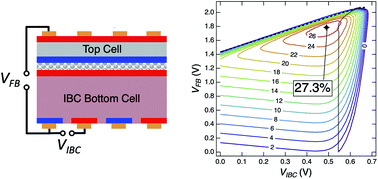Three-terminal III–V/Si tandem solar cells enabled by a transparent conductive adhesive†
Abstract
Tandem or multijunction solar cells are able to convert sunlight to electricity with greater efficiency than single junction solar cells by splitting the solar spectrum across sub-cells with different bandgaps. With the efficiencies of many common single-junction solar cell materials leveling off near their theoretical efficiency limits, there is renewed interest in applying this approach. However, there is ongoing debate as to the best approach for interconnecting sub-cells in series, or whether it is preferable to operate them independently. In this paper, we provide the first experimental demonstration of a tandem cell architecture with three terminals: one on top of the tandem cell, and two beneath it, in interdigitated back contact configuration. The two cells are interconnected with a transparent conductive adhesive, which is compatible with rough surfaces and exhibits negligible series resistance. Combining GaInP and Si sub-cells in this manner allows us to achieve a GaInP/Si tandem cell with a two-terminal efficiency of 26.4 ± 1.0%. We then show that utilizing all three terminals results in an efficiency boost of 0.9 ± 0.2%, to an efficiency of 27.3 ± 1.0%, and discuss the operation of the cell and its two interacting circuits.

- This article is part of the themed collection: Sustainable Energy & Fuels Cover Art


 Please wait while we load your content...
Please wait while we load your content...
